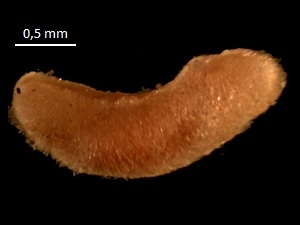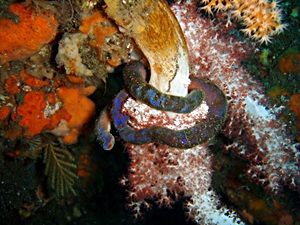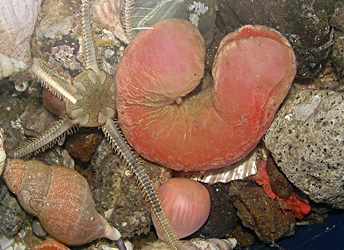Solenogasters (Solenogastres)
Synonym: Neomeniomorpha.
| Class |
Species No. |
| Snails (Gastropoda) |
43.000 |
| Mussels (Bivalvia) |
10.000 |
| Squids (Cephalopoda) |
650 |
| Elephant Tusks (Scaphopoda) |
600 |
| Neopilina (Tryblidia) |
20 |
| Chitons (Placophora) |
750 |
| Solenogastres |
230 |
| Caudofoveata |
120 |
|
|
| Molluscs (Mollusca) |
55.400 |
Species number of molluscs.
 Diagram.
Diagram. |
|
|
As are their Caudofoveata relatives, the
solenogasters also are among the little known shell-less
molluscs ("Aplacophora"). But other than
for example slugs, shell-less gastropods, during whose evolution the
shell has secondarily disappeared, the solenogasters with about 230
species today still belong in the vicinity of those primordial molluscs
which had not yet developed a shell. Instead, solenogasters have a
sturdy outer skin, the cuticula, which is reinforced with calcareous
spikes, the so-called spiculi. To the naked eye, those spikes give a
solenogaster a glossy, furry appearance.
Different from the ground-living caudofoveatans, solenogasters
in general live on cnidarians, for example corals, whose polyps they
eat. Most species grab their prey using their radula and swallow it.
Others puncture their skin and suck the cell fluid from them. In those
species the radula then is often reduced, which is the case for about
one third of all solenogaster species. So the radula is present also
among the Solenogastres,
pointing once again towards the conclusion that the radula is a very
old mollusc character.
A very special character of solenogasters is a ventral furrow
with a short, rudimentary foot, which is completely reduced among their
relatives, the caudofoveatans.
Glands in the ventral furrow of a solenogaster also produce
mucus, so the animal can crawl like a snail does. A head shield, like
among the caudofoveatans, is absent, but solenogasters instead have a
head groove with numerous sense cells. The group's scientific name, Solenogastres,
literally means "animals with a furrowed belly", also a hint towards the
characteristic ventral furrow of those creatures.
| |

An unidentified solenogaster (Neomenia spec.). The
furry
appearance is due to a large number of tiny calcareous spicules.
Source: MBARI. |

Many solenogasters (Epimenia babai) live on
corals
they also feed on. Source:
Atwiki.jp. |
|
As do the caudofoveatans, the solenogasters also have a small
pallial caity at their body's end, in which the double gills are
situated. In the solenogasters, too, the dorsal gonad's efferent duct
mouths into the pericardium and from there into the pallial cavity.
In contrary to the caudofoveatans, solenogasters are
hermaphrodites, which change their sex during their life (similar to slipper limpets):
Younger specimens live as males, while the older ones are females.
Fertilisation takes place internally after a copulation, unlike the external
fertilisation among caudofoveatans.
However, both,
have in common the larval development passing a
planktontic larval stage of the trochophora type. In this regard,
caudofoveatans and solenogasters still are very near the segmented
worms (Annelida),
which also develop passing a similar larval stage.
Additional Information:
Literature:
-
Salvini-Plawen, L.; Mizzaro-Wimmer, M.:
"Praktische Malakologie - Beiträge zur vergleichend anatomischen
Bearbeitung der Mollusken", Vienna 2001.


